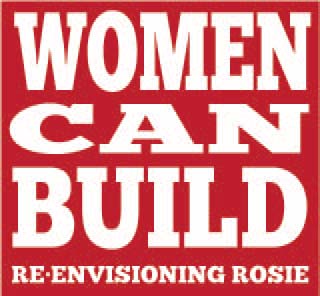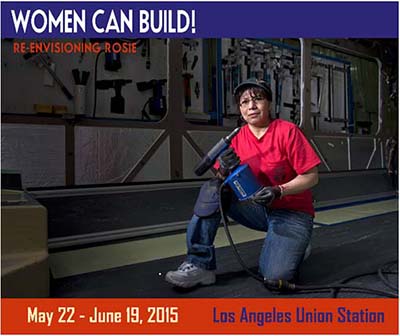‘Women Can Build’ Photo Exhibit and Release of
USC Study of Modern-Day ‘Rosie the Riveters’
Highlight Women Workers,
Outnumbered in U.S. Manufacturing

LOS ANGELES, April 29, 2015 – Rosie the Riveter has seen better days. On May 21, 2015, the
Jobs to Move America coalition will launch the
Women Can Build project with a new study
and an accompanying photography exhibit revealing the overlooked contributions, and decline in hiring since WWII, of the
skilled and hard-working women who build our 21st Century transportation including trams, rail and buses. The new study,
“#WomenCanBuild: Including Women in the Resurgence of Good U.S. Manufacturing Jobs”, issued by the University of
Southern California’s Program for Environmental and Regional Equity (PERE), finds that 87% of the workforce in the
American transit manufacturing industry is male.
Making an impactful visual statement, the Women Can Build photography exhibit—running from May 22 to June 21 at the historic
Los Angeles Union Station—will premiere 15 photos and stories of “modern Rosies”. These photographs, by Pulitzer Prize
recipient Deanne Fitzmaurice, will be displayed alongside never-before-exhibited historic photographs of WWII-era
“Rosie the Riveter” manufacturing workers, from the Library of Congress, connecting past and present.
The “modern Rosies” work for global transit equipment manufacturing companies that have U.S. factories, including Siemens, New Flyer
Industries, Nippon Sharyo, and Kinkisharyo. Many of the women workers who were photographed will share their stories of
challenges and growth at the exhibit’s opening on May 21. In addition to the manufacturing “Rosies”, included in the
exhibit are former Massachusetts Bay Transportation Authority General Manager Dr. Beverly Scott, Los Angeles County Supervisor
Hilda Solis, California Speaker Toni G. Atkins, and former Los Angeles County Federation of Labor Executive Secretary-Treasurer
Maria Elena Durazo.
“Women Can Build says it all: the powerful, beautiful women working in these factories can do anything they set their minds to,”
said Madeline Janis, Director of the Jobs to Move America coalition. “We hope to inspire more young girls to work in heavy
manufacturing, and to encourage the 16 major employers in transit equipment manufacturing to provide more good jobs and
equal opportunity to women in these factories. 75 years after Rosie the Riveter, we can do better than 13% women in the
workforce.”
With this project, Jobs to Move America’s goal is to deliver the message that “women can build” to the top 16 global companies
building mass transportation, and to encourage them to increase opportunities for women on the factory floor in U.S.
manufacturing jobs. The USC PERE study shows:
• The pay disparity, more than other industries, is significant in manufacturing, where women make 74 cents for every dollar
men make in the industry.
• While women make up 47% of the U.S. labor force, they comprise just 30% of the
manufacturing industry workforce, and only 24% of the workforce in the transportation
equipment-specific manufacturing sector. Out of that group, most of the women are in
lower-paying, more clerical positions instead of the desired middle-class building jobs.
• Within transportation, women are the least-represented in the railroad rolling stock
manufacturing sub-industry (13%), half of what they are in motor vehicle and aerospace
manufacturing jobs. This matters for two reasons: (a) sub-industries like railroad rolling stock tend to pay better – the median
annual wage is $45,000 while the median wage for motor vehicle equipment is $35,000 and (b) the rolling stock sub-industry
is being spurred by transit build-out across the nation, as federal and local investments drive new growth.
• Women want good manufacturing jobs. In one survey, over 75% of women agreed that a
manufacturing career is interesting and rewarding, highlighting compensation and
challenging assignments as the most favorable attributes. The survey also found that there is a lack of recruitment programs
targeting women, especially those with advanced degrees. (
Untapped Resource: How Manufacturers Can Attract, Retain,
and Advance Talented Women, Giffi and McNelly)
The complete study will be available on May 21st on the Jobs to Move America website.
Examples of some of the women featured in the photo exhibit:
1.
Ami Rasmussen, an interior assembly technician at the Kinkisharyo railcar factory in Palmdale, CA, a U.S. Army veteran and mother
to two teenage daughters, says, “Women
might think they can’t lift anything heavy, but they’d be surprised that they can do this! Better than half the guys!” She adds,
“I participated in [this] project because…above all, I want to prove to my girls that they can do anything they put their
minds to and commit to. I want to lead by example, to them and to other women.”
2.
Stacey Corcoran, who now works as an electrician at Nippon Sharyo in Rochelle, IL, has worked all over the U.S. for the last two decades. She describes her experience as one of the only female railcar builders by saying, “It depends on where you’re at, you take the good with the bad. Ninety-nine percent of the time, I’ve had no issues with it -- and I’m proud to be able to say that. I have a lot of experience and I've put in many years.”
She sums it up saying, “I’m only four foot four, I build trains, and I’m a girl. What more proof do you need? No matter what we do, we all play an important part.”
3.
Jay Fatima Tapia, an Equipment Operator at a railcar maintenance facility in Los Angeles, and the only woman there for the past three years, has always pushed to find the next position she could learn and master. She hopes for more women in the hiring process, and more public job notices, to encourage more women to apply. “I got interviewed by three men…and it was intimidating,” she says. “’Women can build’ means everything—that a woman can build everything a man can build—AND BETTER.”
American cities spend about $5.4 billion each year purchasing buses and railcars for public transportation systems. These
transportation equipment purchases use federal and local transportation funds, and are administered via contracts with
global manufacturing companies: e.g. Los Angeles county residents voted in Measure R, 65% of which will be used for rail
and bus related projects. U.S. public transit ridership reached 10.8 billion trips in 2014, the largest amount in 58 years
(APTA analysis, Progressive Railroading, 4/10/15). Major growth in the U.S. railcar manufacturing industry is expected as
California’s future high-speed rail system is built. Along with this expansion, the face of manufacturing is changing.
There is a skills gap, compounded by an aging workforce. Even with people looking for jobs, as many as 600,000 manufacturing
jobs remained unfilled due to a shortage of qualified workers.
The Women Can Build study, exhibit and women’s stories are part of a major
campaign to inform and activate the public, and encourage
the manufacturing companies and transit agencies that buy from them to offer more opportunities for women in this changing
and expanding area. Mothers are the sole or primary source of income for a record 40% of households with children under 18.
Women’s access to good, family-supporting manufacturing jobs could provide stability for these families and inspire the next
generation of young women to build.
The
Women Can Build project is supported by the following organizations: Platinum Sponsors - Los Angeles County Metropolitan
Transportation Authority, Surdna Foundation; Silver Sponsors - Ford Foundation, IUE-CWA, the Industrial Division of the
Communications Workers of America, Miguel Contreras Foundation, SAG-AFTRA (Screen Actors Guild-American Federation of
Television and Radio Artists), Women’s Foundation of California; Financial Supporter - Speaker Toni G Atkins.
About Women Can Build:
http://www.womencanbuild.org
About Jobs To Move America (
jobstomoveamerica.org)
Jobs to Move America is a national project to make our transit dollars go the distance. The Jobs to Move America coalition unites more
than 40 community, labor, civil rights, academic, philanthropic, and environmental organizations advocating for cities to make
our transit dollars go the distance — to build better, cleaner public transit systems, to create and retain good manufacturing
jobs, and to generate opportunities for unemployed Americans like veterans and residents of low-income neighborhoods.
Every year, United States transit agencies spend about $5.4 billion on bus and railcar purchases.
 For more information please click here
http://www.womencanbuild.org
For more information please click here
http://www.womencanbuild.org
For map and location click Here!